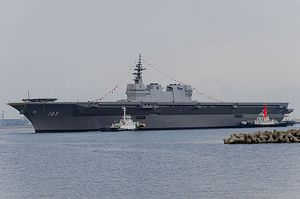Japan’s largest warship since the end of World War II, the helicopter carrier JS Izumo, will protect a U.S. supply ship starting Monday, according to Japanese press reports citing unnamed government officials.
According to the Asahi Shimbun and Jiji Press, the Izumo will leave the port of Yokosuka near Tokyo in what will be its first deployment alongside a U.S. vessel outside an exercise. Japanese reports have not specified which U.S. vessel will see the Izumo‘s protection.
The Izumo will escort the U.S. Navy supply ship “from waters off the Boso Peninsula, in Chiba Prefecture, to the area off Shikoku,” Jiji reported.
The Izumo‘s assignment follows an order by Japanese Defense Minister Tomomi Inada and is permitted under the cabinet’s 2015 reinterpretation of Article 9 of Japan’s pacifist post-war constitution. The laws entered force early last year and give Japanese forces the ability to exercise the right to collective self-defense and expand the range of permitted Japanese Self-Defense Force activities in peacetime.
The Izumo, as the largest ship in the Japanese Maritime Self-Defense Force, drew attention in China when it was commissioned in 2015. With a displacement of 27,000 tons under full load, the Izumo is on par with several smaller aircraft carriers.
Though it lacks a catapult launch system required to allow for its operation as a regular aircraft carrier, the Izumo may be capable of accommodating the F-35B vertical take-off variant of the supersonic U.S. fifth generation fighter designed for the U.S. Marine Corps.
The Izumo is expected to begin a longer deployment soon. It will participate in the U.S.-India-Japan Malabar exercises in the Indian Ocean this July and transit the South China Sea on its way there. The Izumo is expected to make port calls in Indonesia, the Philippines, Singapore, and Sri Lanka.
The Izumo primarily serves the role of an anti-submarine warfare helicopter carrier. A second carrier in the Izumo-class, the JS Kaga, was commissioned in March 2017. Japan officially classifies the vessels “helicopter destroyers,” despite their flat-top decks.

































